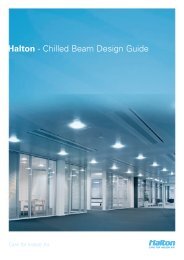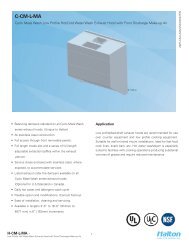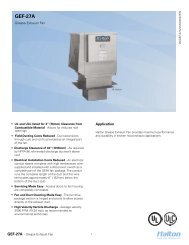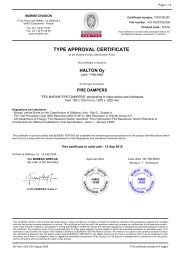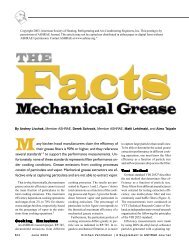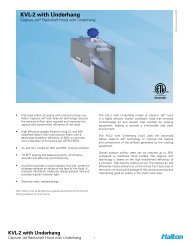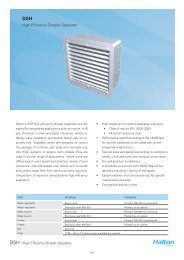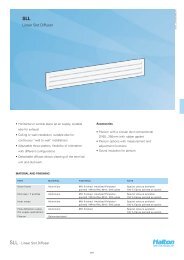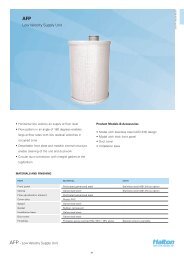Demand-Controlled Ventilation For Commercial ... - Halton Company
Demand-Controlled Ventilation For Commercial ... - Halton Company
Demand-Controlled Ventilation For Commercial ... - Halton Company
You also want an ePaper? Increase the reach of your titles
YUMPU automatically turns print PDFs into web optimized ePapers that Google loves.
1,200<br />
1,100<br />
1,000<br />
Figure 2: Griddle testing.<br />
<strong>For</strong> an exhaust temperature-based system<br />
operating on a curve, exhaust airflow<br />
increased to the minimum idle rate of<br />
80% of design. After patties were placed<br />
on the griddle, the airflow increased gradually<br />
with the exhaust temperature and<br />
then fell as the temperature decreased<br />
near the end of the cooking cycle. Note<br />
that airflow was not at design for the entirety<br />
of the cooking process.<br />
When operating with a constant temperature<br />
setpoint of 100°F (38°C), the<br />
system was able to reach and maintain<br />
design airflow following placing patties<br />
on the cooking surface. However, the<br />
initial response was not as fast as obtained<br />
with the CAS.<br />
This test showed that the constant temperature setpoints of<br />
90°F and 130°F (32°C and 54°C) were not suitable for the application.<br />
With a 90°F (32°C) setpoint the system remained at<br />
design airflow at all times due to the setpoint being lower than<br />
the exhaust temperature, even at idle conditions. A site configured<br />
to operate in this manner was no different than having a<br />
standard canopy hood without DCV. The opposite was true of<br />
Airflow (cfm)<br />
900<br />
800<br />
700<br />
600<br />
Temperature<br />
+ CAS<br />
Temperature<br />
Curve<br />
1:02:00p<br />
1:06:55p<br />
1:11:52p<br />
1:17:04p<br />
1:22:18p<br />
1:27:34p<br />
1:32:55p<br />
1:38:21p<br />
1:43:53p<br />
1:49:22p<br />
1:54:50p<br />
2:00:13p<br />
2:05:36p<br />
2:10:49p<br />
2:15:49p<br />
2:20:44p<br />
2:25:33p<br />
2:30:12p<br />
2:34:45p<br />
2:39:16p<br />
2:43:50p<br />
2:48:18p<br />
2:52:48p<br />
2:57:19p<br />
3:01:50p<br />
3:06:20p<br />
Airflow<br />
Constant<br />
Temperature,<br />
SP = 90°F<br />
Patties On<br />
Design Airflow<br />
Constant<br />
Temperature,<br />
SP = 100°F<br />
Constant<br />
Temperature,<br />
SP = 130°F<br />
Duct Temperature<br />
140<br />
130<br />
120<br />
110<br />
100<br />
90<br />
80<br />
70<br />
60<br />
the 130°F (54°C) setpoint. The system remained at idle airflow<br />
as the exhaust temperature never exceeded the setpoint, resulting<br />
in both heat and cooking effluent spilling to the space.<br />
Open-Vat Fryer<br />
Figure 3 shows data taken for the open-vat fryer. When<br />
testing with the CAS, the idle airflow rate fluctuated between<br />
Temperature (°F)<br />
Advertisement formerly in this space.<br />
40 ASHRAE Journal November 2012



